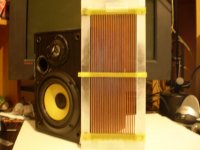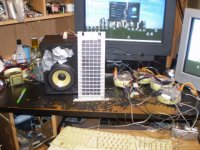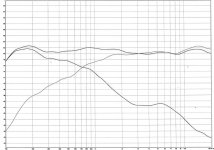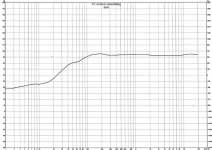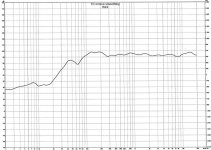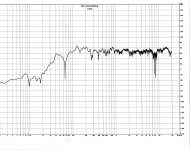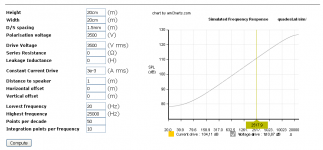How large do we need to make a Electrostatic tweeter to match nicely with a conventional mid bass driver.
While I love my full range electrostatics I would also like a tiny speaker, and am no particular fan of moving coil tweeters, and ribbons typically require a 3 way.
If we target a 110 dB SPL to around what ever is needed to cross over with a good 4" to 6" mid-bass driver. How small can we make the electrostatic speaker, and still require no more than 30 W to drive it and about the same power to drive the bass. I assume we will go active.
While I love my full range electrostatics I would also like a tiny speaker, and am no particular fan of moving coil tweeters, and ribbons typically require a 3 way.
If we target a 110 dB SPL to around what ever is needed to cross over with a good 4" to 6" mid-bass driver. How small can we make the electrostatic speaker, and still require no more than 30 W to drive it and about the same power to drive the bass. I assume we will go active.
About 3" x 9" to 4" x 12" is good.
Use a very good stator coating and run a bias voltage of about 7Kv to 8.5 Kv and you will reach your goals.
Or at least very close to them.
I got +105db under such conditions with only a 50-100 watt amp.
I have stated these figures several times in various threads.
I was using only a 5.25" driver so my low end peak was limited in order to be flat.
The ESL's could do much much more with a measured 110db than what the woofer could do to keep up.
That is the pretty much the performance I got with my desktop models.
If you electrically segment the stator you can still go wider like 6" and still have a wide and even horizontal dispersion.
This will allow a bit more Ooomph at the lower end, and have a lower reasonable crossover point.
Much more lower that about 800Hz to 1200Hz!!
I was using a D/S of about .072" and I have increased this somewhat on my newer version for better room for Diaphragm movement in the 200Hz to 300Hz range.
The photo is of my latest untested version (that I had made two years ago), designed to meet the above requirements and push the bias level even higher toward 10Kv-13.5Kv.
The next set of photos are of my test panel as described in the threads and the calibrated measurements of it the very day I pushed it to far and it finally gave up for good.
It really wasn't designed to be pushed as far as I did it, but it was a trooper to work well enough to do it several times and allow me to finally get some solid data.
The measurement were set at 95db and at a 10v peak signal into a 1:160 transformation ratio and i think my normal 6.8kv of bias.
Running the bias up to 8.5Kv-10 Kv range yeilded me another 3-4 db of efficiency with no change in the drive level.
I ran them at 10Kv for quite a while on this last test, But it was pushing the integrity of my stator coating until their final ultimate demise.
The efficiency of this setup at 6.8KV was measured at about 89-91db with a 5v peak signal feeding the step up transformers.
There was slight 3db peak slope in the otherwise flat response curve that accounts for the 91db and is probably some sort of room reflection of my test setup when I did the test.
Those conditions where refined for the calibrated curve as shown and the 89db for a 5Vpeak corresponds to the 95db level for a 10v peak input using a sine wave test tone.
FWIW
jer
Use a very good stator coating and run a bias voltage of about 7Kv to 8.5 Kv and you will reach your goals.
Or at least very close to them.
I got +105db under such conditions with only a 50-100 watt amp.
I have stated these figures several times in various threads.
I was using only a 5.25" driver so my low end peak was limited in order to be flat.
The ESL's could do much much more with a measured 110db than what the woofer could do to keep up.
That is the pretty much the performance I got with my desktop models.
If you electrically segment the stator you can still go wider like 6" and still have a wide and even horizontal dispersion.
This will allow a bit more Ooomph at the lower end, and have a lower reasonable crossover point.
Much more lower that about 800Hz to 1200Hz!!
I was using a D/S of about .072" and I have increased this somewhat on my newer version for better room for Diaphragm movement in the 200Hz to 300Hz range.
The photo is of my latest untested version (that I had made two years ago), designed to meet the above requirements and push the bias level even higher toward 10Kv-13.5Kv.
The next set of photos are of my test panel as described in the threads and the calibrated measurements of it the very day I pushed it to far and it finally gave up for good.
It really wasn't designed to be pushed as far as I did it, but it was a trooper to work well enough to do it several times and allow me to finally get some solid data.
The measurement were set at 95db and at a 10v peak signal into a 1:160 transformation ratio and i think my normal 6.8kv of bias.
Running the bias up to 8.5Kv-10 Kv range yeilded me another 3-4 db of efficiency with no change in the drive level.
I ran them at 10Kv for quite a while on this last test, But it was pushing the integrity of my stator coating until their final ultimate demise.
The efficiency of this setup at 6.8KV was measured at about 89-91db with a 5v peak signal feeding the step up transformers.
There was slight 3db peak slope in the otherwise flat response curve that accounts for the 91db and is probably some sort of room reflection of my test setup when I did the test.
Those conditions where refined for the calibrated curve as shown and the 89db for a 5Vpeak corresponds to the 95db level for a 10v peak input using a sine wave test tone.
FWIW
jer
Attachments
Last edited:
If 110dB @ 1m is truly the requirement you would need a 23cm diameter ESL to cross over in the 2kHz - 3kHz range. If you can move the crossover a little higher (or lower your SPL requirement) you could manage with a 17cm diameter ESL. The output capability increases +6dB for every doubling of panel area.If we target a 110 dB SPL to around what ever is needed to cross over with a good 4" to 6" mid-bass driver. How small can we make the electrostatic speaker, and still require no more than 30 W to drive it and about the same power to drive the bass. I assume we will go active.
Just to clarify, these area and SPL numbers are for a dipole ESL panel.
You can calculate them for yourself at this site:
Electrostatic Loudspeaker (ESL) Simulator
With typical 1.5mm D/S spacing, use 3500V polarizing voltage and 3500Vrms Drive voltage to get a good estimate of peak output capability for an ESL. Change dimensions and distance to see effect on SPL.
More details on using the ESL calculator here:
http://www.diyaudio.com/forums/planars-exotics/258958-help-esl-simulator.html#post3988441
Attachment #2 of this post shows how to get a flat response using a series resistor:
http://www.diyaudio.com/forums/planars-exotics/258958-help-esl-simulator.html#post3989632
Attachments
Last edited:
In reality it took about 100watts to get 110DB with a 6.8Kv bias.
My as measured efficiency was 89db for a 5V peak signal (close enough to 4Vpeak for a 1 watt reference).
So for 100 watts=20db 20+89=109db !!
And then for everytime you double a voltage it means +6db of more SPL.
Doubling of the bias is the easiest.
So if I can run a 14Kv bias than it would only take 50 watts at 20v peak to get to 110db or so.
I did this a couple of times but my stator coating was starting to fail at anything above 12Kv.
I was running a 8.5Kv bias and about 50v peak input when it happened (burned for the last time).
Anyhow 10.2Kv of bias gave me approximately +3db more so now my efficiency is now 91db as measured.
So from 5v to 40v (for a 100watt amp) this is a doubling of the voltage of three times for a +18db.
Therefore 18+91=109db as measured with my SPL meter in my test at 1 meter from the panel.
Being that I normally sit no more than a .5 meter from them you can add 3db to that final figure.
And IF I could run them at a full 14kv of bias that adds +6db from my nominal 6.8kv.
And add another say 2-3db from 40v peak of drive to 60v peak ( the equiv. of a 200-225 watt amp).
I was also using my Crown DC300a for the extreme tests,
Our total now comes to approximately 109+2.5+6=117.5db from a 3.25"x 9.75" ESL!!!
Double the surface area and add another 6db to that!!
So by the same token a 3.25" x 19.25" ESL could produce 120db with just a 150 to 200watt amp or 117.5 with a 100 watt amp (40v peak) !!!
And we would still have our 111.5db from only a 50watt amp.
I got this easily with my cheapy AWIA 80watt amp under normal conditions.
Only the little 5.25" Sony woofer I was using couldn't keep up.
That is why the graphs are set to 95DB.
That little woofer was doing all it could do below 100hz without hitting its stops and flying apart!!
From the very same single panel as shown in the photo I posted.
I didn't even have the added benefit of running two panels at the time.
The 115db range is what I know I had when I didn't even have an SPL meter at the time back in 2010 when I had First posted my info on this project.
I was running about 6.5Kv-7.5Kv of bias then and 20-25KV p--p across the stator's (as confirmed by my scope) for 20 minutes straight the First time it arced over and caught fire.
Like I have said before it was loud enough to scare even me out of the room at that level and do play a very loud guitar.
Now, I know that most probably don't like my ideas of pushing the voltages and I wouldn't expect the average DIY'er to do so either!!!
But it was the only way for me to find out what I wanted to know since nobody had any answers for what I was seeking to find.
I did all of this in the name of DIY ESL Research.
And yes the ESL Simulator is pretty much right on from the results of my tests.
Very nice work on that Calculator indeed!!!
But the question did arise of how small can we make an ESL and still get 110db at 1 meter with a 30 watt amp.
As that has been my criteria every since I started building ESL's in the First place from the beginning in 2003.
Cheers !!
jer
My as measured efficiency was 89db for a 5V peak signal (close enough to 4Vpeak for a 1 watt reference).
So for 100 watts=20db 20+89=109db !!
And then for everytime you double a voltage it means +6db of more SPL.
Doubling of the bias is the easiest.
So if I can run a 14Kv bias than it would only take 50 watts at 20v peak to get to 110db or so.
I did this a couple of times but my stator coating was starting to fail at anything above 12Kv.
I was running a 8.5Kv bias and about 50v peak input when it happened (burned for the last time).
Anyhow 10.2Kv of bias gave me approximately +3db more so now my efficiency is now 91db as measured.
So from 5v to 40v (for a 100watt amp) this is a doubling of the voltage of three times for a +18db.
Therefore 18+91=109db as measured with my SPL meter in my test at 1 meter from the panel.
Being that I normally sit no more than a .5 meter from them you can add 3db to that final figure.
And IF I could run them at a full 14kv of bias that adds +6db from my nominal 6.8kv.
And add another say 2-3db from 40v peak of drive to 60v peak ( the equiv. of a 200-225 watt amp).
I was also using my Crown DC300a for the extreme tests,
Our total now comes to approximately 109+2.5+6=117.5db from a 3.25"x 9.75" ESL!!!
Double the surface area and add another 6db to that!!
So by the same token a 3.25" x 19.25" ESL could produce 120db with just a 150 to 200watt amp or 117.5 with a 100 watt amp (40v peak) !!!
And we would still have our 111.5db from only a 50watt amp.
I got this easily with my cheapy AWIA 80watt amp under normal conditions.
Only the little 5.25" Sony woofer I was using couldn't keep up.
That is why the graphs are set to 95DB.
That little woofer was doing all it could do below 100hz without hitting its stops and flying apart!!
From the very same single panel as shown in the photo I posted.
I didn't even have the added benefit of running two panels at the time.
The 115db range is what I know I had when I didn't even have an SPL meter at the time back in 2010 when I had First posted my info on this project.
I was running about 6.5Kv-7.5Kv of bias then and 20-25KV p--p across the stator's (as confirmed by my scope) for 20 minutes straight the First time it arced over and caught fire.
Like I have said before it was loud enough to scare even me out of the room at that level and do play a very loud guitar.
Now, I know that most probably don't like my ideas of pushing the voltages and I wouldn't expect the average DIY'er to do so either!!!
But it was the only way for me to find out what I wanted to know since nobody had any answers for what I was seeking to find.
I did all of this in the name of DIY ESL Research.
And yes the ESL Simulator is pretty much right on from the results of my tests.
Very nice work on that Calculator indeed!!!
But the question did arise of how small can we make an ESL and still get 110db at 1 meter with a 30 watt amp.
As that has been my criteria every since I started building ESL's in the First place from the beginning in 2003.
Cheers !!
jer
Last edited:
Thanks guys. Thinking carefully I don’t think we really need 110 dB but I’m going to keep looking at it as a reasonable safety margin.
Looking at your suggestions, your are both suggesting much larger D/S spacing than I thought.
bolserst: 1.5mm
jer: 0.072" == 1.8288mm
Having only made and ESL with 0.3 mm D/S spacing your proposals seem to be for large D/S spacing.
Looking at Piston Excursion calculator
With a 4" driver, playing 1000Hz at 110 dB SPL @ 1m we only need 0.22 mm Xmax. For for 500Hz, at 110 dB SPL we will need 0.8 mm.
Why not go for a 0.5 to 1 mm D/S spacing?
Looking at your suggestions, your are both suggesting much larger D/S spacing than I thought.
bolserst: 1.5mm
jer: 0.072" == 1.8288mm
Having only made and ESL with 0.3 mm D/S spacing your proposals seem to be for large D/S spacing.
Looking at Piston Excursion calculator
With a 4" driver, playing 1000Hz at 110 dB SPL @ 1m we only need 0.22 mm Xmax. For for 500Hz, at 110 dB SPL we will need 0.8 mm.
Why not go for a 0.5 to 1 mm D/S spacing?
I mentioned 1.5mm spacing because that is the most common spacing used....Why not go for a 0.5 to 1 mm D/S spacing?
I have built ESLs with 0.75mm spacing for use as RTR tweeter replacement.
Halving the D/S spacing halves the required voltages, but the max SPL is the same.
So smaller gap will not get you higher max SPL but it will allow you to get there with lower voltages.
You are correct that the motion of the membrane due to audio signal will be very small.
However, remember that the diaphragm will be deflected from its center position when bias voltage is applied. But, as long as you are able to build flat, tight tolerance stator and spacer assemblies you can work with the smaller gaps you mention.
Yes, in my tests the D/S of .072"-.075" of my original Panel was quite sufficient for most cases.
I used just standard thickness of plexiglass.
Even at the extreme levels it was fine for anything above 400hz to 300Hz or so.
But below 300hz and at 200Hz I got clipping of the Diaphragm in to the stator's as verified by my scope showing flat topping of the waveform of the signal coming off of my test microphone.
I verified this by moving the mic. father away from the panel to make sure that it wasn't the mic clipping.
So switched out the 1/16" frames for the 3/32" ones that I had already made and I had no issues of such clipping after that except when I hit the resonate frequency of the diaphragm in the 70Hz to 90hz range.
Also as mentioned I just simply raised the Bias voltage to compensate for the larger D/S and got the same SPL with the same drive voltage but no nasty clipping or slapping of the diaphragm into the stators.
It was loud and clean!!
Now, Yes 110db is quite loud!!!
But, It is not a unreasonable goal considering on how far away your listening position may be!!!
For instance my Desktop unit is only .5 meter away normally, But my room is 18 feet long and if I were to put them on the far end I will lose approximately 8-10db at my listening position at 14-16 feet away.
And even though I do like it loud when I am playing along with my guitar and other rare occasions, I have found that 105db is my comfort zone to set my mains at.
This means that they have to produce at least 114db, and when they were working I could get 109db clean at my listening position.
So, when I was listening to my Desktop ESL (just one) I had found the even at 90db of SPL it was more than enough to be comfortable and they could do 95db flat as my charts have shown at 1 meter.
Even the roll off at 100hz didn't seem to be much of a problem to cause any degradation of the music I was playing on the low end ( Rock Stuff with lots of Bass Guitar and clean Kick drums like Montrose , Spin Doctors and such) at a full 95db!!
And the clarity of ELP's "From the Beginning" was just astounding!!!
Especially, When I was only listening at an average of 85db to 88db I was able to use a bit more low end and to be flat down to 40Hz or so and it still played with much authority only it wasn't earth shaking!!!
But very very moving as the way ESL's are anyhow!!
FWIW
jer
I used just standard thickness of plexiglass.
Even at the extreme levels it was fine for anything above 400hz to 300Hz or so.
But below 300hz and at 200Hz I got clipping of the Diaphragm in to the stator's as verified by my scope showing flat topping of the waveform of the signal coming off of my test microphone.
I verified this by moving the mic. father away from the panel to make sure that it wasn't the mic clipping.
So switched out the 1/16" frames for the 3/32" ones that I had already made and I had no issues of such clipping after that except when I hit the resonate frequency of the diaphragm in the 70Hz to 90hz range.
Also as mentioned I just simply raised the Bias voltage to compensate for the larger D/S and got the same SPL with the same drive voltage but no nasty clipping or slapping of the diaphragm into the stators.
It was loud and clean!!
Now, Yes 110db is quite loud!!!
But, It is not a unreasonable goal considering on how far away your listening position may be!!!
For instance my Desktop unit is only .5 meter away normally, But my room is 18 feet long and if I were to put them on the far end I will lose approximately 8-10db at my listening position at 14-16 feet away.
And even though I do like it loud when I am playing along with my guitar and other rare occasions, I have found that 105db is my comfort zone to set my mains at.
This means that they have to produce at least 114db, and when they were working I could get 109db clean at my listening position.
So, when I was listening to my Desktop ESL (just one) I had found the even at 90db of SPL it was more than enough to be comfortable and they could do 95db flat as my charts have shown at 1 meter.
Even the roll off at 100hz didn't seem to be much of a problem to cause any degradation of the music I was playing on the low end ( Rock Stuff with lots of Bass Guitar and clean Kick drums like Montrose , Spin Doctors and such) at a full 95db!!
And the clarity of ELP's "From the Beginning" was just astounding!!!
Especially, When I was only listening at an average of 85db to 88db I was able to use a bit more low end and to be flat down to 40Hz or so and it still played with much authority only it wasn't earth shaking!!!
But very very moving as the way ESL's are anyhow!!
FWIW
jer
Last edited:
P.S. My new design is still set at 1.85mm or .072" but I can easily add an exact amount of more spacing should I need to when I do finally finish it and start some testing.
The coating on the stator's have already passed the HV tests I have given them for breakdown at 14Kv and above using a mock up test with a transformer connected and amplifier running as well as my variable HV supply.
I am hoping to get good results of a crossover down in the 300-600hz range but I may need to use a wider panel for this to happen smoothly below 600Hz or so.
I have a 6" by 18" electrically segmented stator in mind for my next design using some of my .062" TIG rod and one or two of my 8" subwoofers.
I will get some thinner .035" or .045" stock sometime in the future for more builds.
More on this later.
The coating on the stator's have already passed the HV tests I have given them for breakdown at 14Kv and above using a mock up test with a transformer connected and amplifier running as well as my variable HV supply.
I am hoping to get good results of a crossover down in the 300-600hz range but I may need to use a wider panel for this to happen smoothly below 600Hz or so.
I have a 6" by 18" electrically segmented stator in mind for my next design using some of my .062" TIG rod and one or two of my 8" subwoofers.
I will get some thinner .035" or .045" stock sometime in the future for more builds.
Maybe you should take a look at my sandwich esl ? yummie. its damn tiny has verry decent to high spl. and could even fit into an a large cone driver.
If tranformers where not that expensive i would persui this further. but im low on cash. and i want to someday produce exoctic loudspeakers for a decent price.
oh i missed the part about not wanting a 3 way. well the tiny esl i used could be crossed at i think 1000 i believe. thats still almost 2k lower then most tweeters. i can imagine a simple paper woofer can reach 1khz pretty easy (and beyond)
http://www.diyaudio.com/forums/planars-exotics/272742-sandwich-esl-yummie-3.html
If tranformers where not that expensive i would persui this further. but im low on cash. and i want to someday produce exoctic loudspeakers for a decent price.
oh i missed the part about not wanting a 3 way. well the tiny esl i used could be crossed at i think 1000 i believe. thats still almost 2k lower then most tweeters. i can imagine a simple paper woofer can reach 1khz pretty easy (and beyond)
http://www.diyaudio.com/forums/planars-exotics/272742-sandwich-esl-yummie-3.html
Last edited:
Wondering why this thread fizzled and died just shortly after it was posted...
Because OP stopped replying? Too many complications with a design like this?
Not worth the time/effort, and just easier to go with full panel?
What about an ESL tweeter in a bookshelf-type enclosure, foregoing dipole pattern?
Terrible idea? ... Do-able, but with big compromises?
@WrineX and Jer: Did either of you explore this further?
Cheers
-Steve
Because OP stopped replying? Too many complications with a design like this?
Not worth the time/effort, and just easier to go with full panel?
What about an ESL tweeter in a bookshelf-type enclosure, foregoing dipole pattern?
Terrible idea? ... Do-able, but with big compromises?
@WrineX and Jer: Did either of you explore this further?
Cheers
-Steve
Hi,
a pure esl tweeter isn't as superior -if at all- to a dynamic tweeter as a wideband esl is over a dynamic 2- or 3-way combo.
In fact there are parameters where the esl excels in the midrange and the dynamic speaker in the upper highs.
I see two major advantages on the esl side ....
- its wideband capability, thereby reducing the number of xover breaks
- the posssibility to shape membrane area frequency dependant (segmenting)
Both advantages become irrelevant with true tweeters.
jauu
Calvin
a pure esl tweeter isn't as superior -if at all- to a dynamic tweeter as a wideband esl is over a dynamic 2- or 3-way combo.
In fact there are parameters where the esl excels in the midrange and the dynamic speaker in the upper highs.
I see two major advantages on the esl side ....
- its wideband capability, thereby reducing the number of xover breaks
- the posssibility to shape membrane area frequency dependant (segmenting)
Both advantages become irrelevant with true tweeters.
jauu
Calvin
...there are parameters where the esl excels in the midrange and the dynamic speaker in the upper highs.
I'm don't quite agree with those words, but I just installed some 1 1/8 inch silk goo-infused dome tweeters (can go as low as 1800 Hz) in my winter home system.
For a long time, I've thought tweeter power capability is very desirable and the silk domes can play brass instruments very loud and agreeably. Long ago, I made tweeters with 9 domes (3 x 3) on a cylindrical contoured box. Wonderful.
Hard to get loudness from my DIY ESLs because the speaker impedance gets very low at high frequencies and even my brutish amp complains early. Any fixes?
But once again, I'd take the purity of the ESLs as my first priority.
Ben
Ben I dont have much to contribute to your esl questions so this is just for my own benefit from a marketing standpoint.
Im curious as you seem to be looking for a "small" tweeter that can go to about 500 hz?
1- what If there was a smallish free swinging ribbon say around 6-8 inches long, 1/2-3/4 in wide that could go that low. Would that be of interest to you?
2- why try to go that low with 5-6 inch cone? seems 1khz would be a better choice?
Im curious as you seem to be looking for a "small" tweeter that can go to about 500 hz?
1- what If there was a smallish free swinging ribbon say around 6-8 inches long, 1/2-3/4 in wide that could go that low. Would that be of interest to you?
2- why try to go that low with 5-6 inch cone? seems 1khz would be a better choice?
so this is just for my own benefit from a marketing standpoint.
Im curious as you seem to be looking for a "small" tweeter that can go to about 500 hz?
My only purposes were:
1. in supporting Calvin's post, to agree that some non-ESL tweeters aren't bad and some go low, loud, disperse, efficient, and cheap, and
2. I wish I knew a fix get my preferred ESLs to play high frequencies louder because the matching transformer impedance gets so low at high frequencies even my powerful amp burps.
B.
Wondering why this thread fizzled and died just shortly after it was posted...
Because OP stopped replying? Too many complications with a design like this?
Not worth the time/effort, and just easier to go with full panel?
What about an ESL tweeter in a bookshelf-type enclosure, foregoing dipole pattern?
Terrible idea? ... Do-able, but with big compromises?
@WrineX and Jer: Did either of you explore this further?
Cheers
-Steve
well i made this sandwich esl that reached 800 hz. at pretty decent levels with small measurements. exactly for this reason to m8 with dynamic woofer midrange. still want to make on that goes lower down to 300hz. with moderate diemension and circular or oval. with rings. i did not gave up ont he idea yet. but it is allot of work and im kiond of limited by materials. pcb works but is just not strong enough. i bought plastic screws to bolt the panels together at a few points in the midle just like quad did to make the stators more sturdy. but i did not try yet. no time
I hear you about no time..ha!
So, you were wanting to match point source radiation of mid/woofer?, am I understanding that right?
Guess it never occurred to me, but makes total sense now that I think about it..
BTW, those ESLs that you came up with sound promising for a good project someday..
One of the main reasons I 'bumped' this thread, is because I saw the JansZen thread earlier this week.
Do those little panels radiate in point source?
(I guess I don't know how they incorporate the ESL into their product.)
Point about that though:
A lot of people think ESLs are 'messy' and therefore not worth the trouble.
Most here know that they are very much worth the 'trouble' , but to 'regular' people, a panel nested inside a bookshelf is probably appealing...
Muse-on please, very interesting, all of this...
Cheers
So, you were wanting to match point source radiation of mid/woofer?, am I understanding that right?
Guess it never occurred to me, but makes total sense now that I think about it..
BTW, those ESLs that you came up with sound promising for a good project someday..
One of the main reasons I 'bumped' this thread, is because I saw the JansZen thread earlier this week.
Do those little panels radiate in point source?
(I guess I don't know how they incorporate the ESL into their product.)
Point about that though:
A lot of people think ESLs are 'messy' and therefore not worth the trouble.
Most here know that they are very much worth the 'trouble' , but to 'regular' people, a panel nested inside a bookshelf is probably appealing...
Muse-on please, very interesting, all of this...
Cheers
Last edited:
Thanks Calvin, for all the information...Hi,
a pure esl tweeter isn't as superior -if at all- to a dynamic tweeter as a wideband esl is over a dynamic 2- or 3-way combo.
In fact there are parameters where the esl excels in the midrange and the dynamic speaker in the upper highs.
I see two major advantages on the esl side ....
- its wideband capability, thereby reducing the number of xover breaks
- the posssibility to shape membrane area frequency dependant (segmenting)
Both advantages become irrelevant with true tweeters
The two listed advantages I agree with.
But what about a third? Namely distortion... Should be much lower with ESL, no?
Any further comments very much appreciated...
Hi,
a tweeter imho is a driver playing above at least 2kHz in a 2-way and >3kHz in a multi-way.
Dynamic tweeters can be very low in distortion here also.
A esl tweeter isn't superior in this regard per se.
The mass/drive-force relationship of a dome tweeter can be as good and even better.
It's small size guarantees for a wider dispersion.
It's easier to drive and to achieve high SPLs.
A esl tweeter requires high precision manufacturing as You're dealing with air gaps of 0.5mm and less ..... even smaller but similar in dimensions to headphone panels.
A optimized stator design required very small holes/openings that's manufacturing could well be beyond the typical DIYer's capabilities (fine meshed structures).
Things are much easier for larger panels and they use the inherent superiority of the esl in the midrange to an advantage.
jauu
Calvin
a tweeter imho is a driver playing above at least 2kHz in a 2-way and >3kHz in a multi-way.
Dynamic tweeters can be very low in distortion here also.
A esl tweeter isn't superior in this regard per se.
The mass/drive-force relationship of a dome tweeter can be as good and even better.
It's small size guarantees for a wider dispersion.
It's easier to drive and to achieve high SPLs.
A esl tweeter requires high precision manufacturing as You're dealing with air gaps of 0.5mm and less ..... even smaller but similar in dimensions to headphone panels.
A optimized stator design required very small holes/openings that's manufacturing could well be beyond the typical DIYer's capabilities (fine meshed structures).
Things are much easier for larger panels and they use the inherent superiority of the esl in the midrange to an advantage.
jauu
Calvin
- Status
- This old topic is closed. If you want to reopen this topic, contact a moderator using the "Report Post" button.
- Home
- Loudspeakers
- Planars & Exotics
- Electrostatic Tweeter / Midrange
